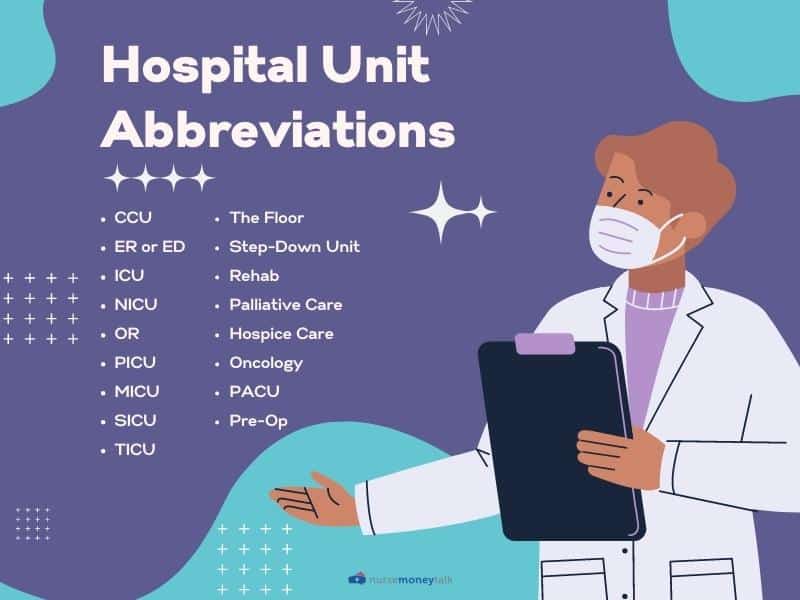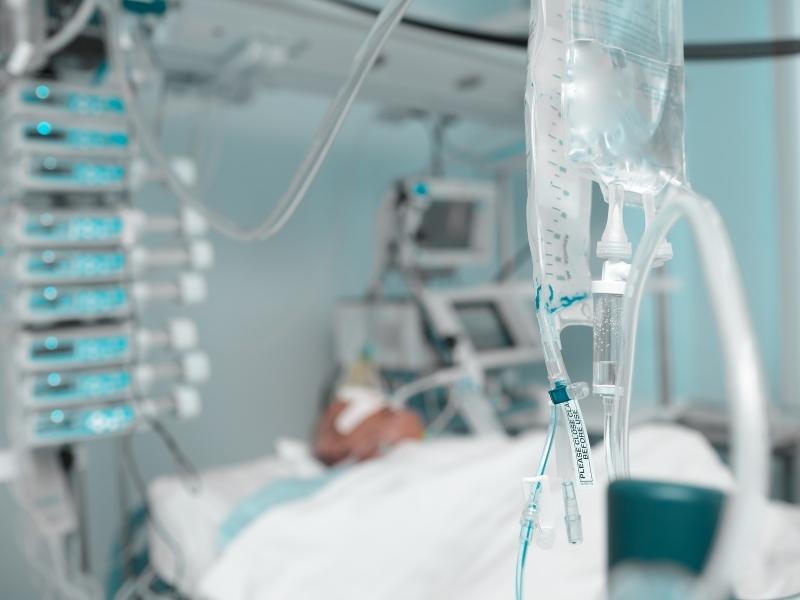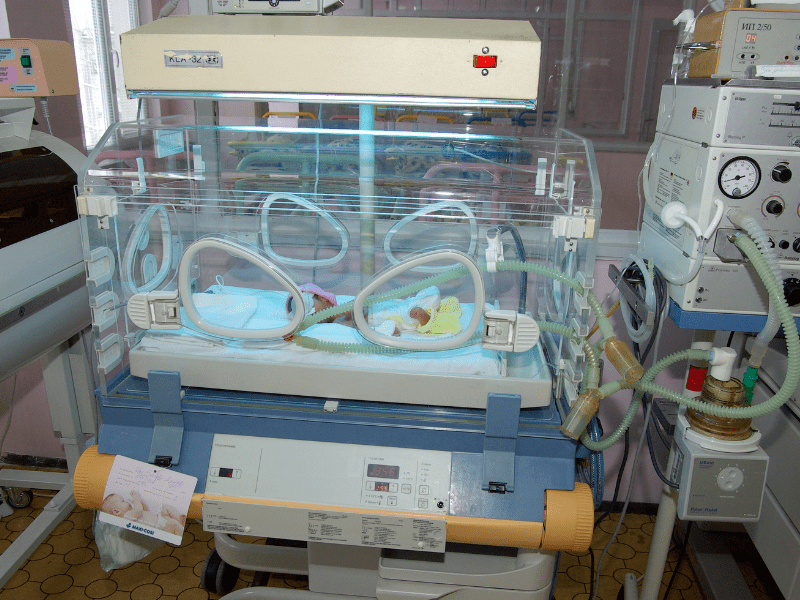You will constantly hear acronyms thrown around when working in a hospital or healthcare setting.
Some are pretty obvious, but others are more obscure.
This article features the more common hospital unit acronyms you’ll encounter.
Hospital Unit Abbreviations

As you’re looking through this let me know in the comment section if there are any acronyms you’ve seen that should be added to this list.
CCU
The cardiac care unit (CCU) in a hospital is a specialized area that provides intensive care for patients with heart conditions.
This can include everything from heart attacks and unstable angina to cardiac surgery.
The CCU is staffed by a team of cardiologists, nurses, and other health professionals trained to deal with cardiac emergencies.
ER or ED
The emergency room (ER) or emergency department (ED) is the part of the hospital that provides immediate care for patients with serious illnesses or injuries.
It is typically staffed by a team of ER doctors, nurses, and other medical professionals specifically trained to deal with life-threatening situations
ICU

The Intensive Care Unit, or ICU, is a particular hospital area for critically ill patients with complex medical ailments.
These patients need close monitoring and constant care, which is why they are placed in the ICU.
The ICU team comprises specially trained doctors, nurses, and other medical professionals with experience caring for critically ill patients.
The ICU is the highest level of care in the hospital setting.
OR
OR is an abbreviation for the Operating Room. The operating room in a hospital is the place where surgeries are performed.
It’s usually a large room with bright lights and prepped surfaces. There are often several operating rooms in a hospital, each designated for a different type of surgery.
For example, there might be an operating room for orthopedic surgery, neurosurgery, and general surgery.
The operating room team typically includes surgeons, anesthesiologists, nurse anesthesia providers, circulating nurses, and scrub nurses.
These professionals work together to ensure that each surgery is performed safely and successfully.
PICU
The pediatric intensive care unit, or PICU, is the area of the hospital that provides care for critically ill or injured children.
Children admitted to the PICU usually have serious medical conditions requiring close monitoring and treatment.
Some of the most common reasons for admission to the PICU include respiratory distress, heart failure, sepsis, and neurological disorders.
NICU

The neonatal intensive care unit, or NICU, is a particular hospital area that provides around-the-clock care for premature babies and sick newborns.
The NICU team includes doctors, nurses, and other specialists trained to care for these vulnerable patients
MICU
The medical intensive care unit, or MICU, is a hospital unit that provides care for patients with serious and life-threatening medical conditions.
The MICU team consists of doctors, nurses, and other medical professionals specially trained to handle these complex cases.
Patients in the MICU typically have multiple medical problems and may require specialized treatments, such as mechanical ventilation.
The goal of the MICU team is to provide comprehensive, coordinated care for these critically ill patients. In addition to treatment, the MICU also provides support for families and loved ones during this difficult time.
SICU
The surgical intensive care unit, or SICU, is a specialized hospital unit that provides care for patients who have undergone surgery.
The SICU team includes surgeons, anesthesiologists, nurses, and other professionals working together to provide expert patient care.
Wondering what the difference is between the MICU and the SICU? Check out the linked article for more information.
TICU
The transplant intensive care unit (TICU) is a hospital unit that provides care for patients who have undergone organ transplant surgery.
The transplant ICU team includes surgeons, nurses, and other healthcare professionals specially trained in transplant care.
The Floor

The medical-surgical floor in a hospital is a general ward that provides care for patients with a wide range of medical conditions.
This type of floor is typically staffed by nurses and doctors with experience caring for patients with multiple and diverse medical needs.
The medical-surgical floor is often the busiest area of the hospital, as is usually where patients are first admitted when they come to the hospital.
Step-Down Unit
A step-down hospital unit provides care for patients who are stable enough to be transferred from the intensive care unit (ICU) but still require close monitoring.
These units are sometimes referred to as intermediate or transitional care units.
The staff in a step-down unit includes nurses, respiratory therapists, and other specialized personnel trained to provide this level of care.
Patients in a step-down unit are typically monitored more closely than those on the med-surg floor but less closely than those in an ICU.
Rehab
The rehabilitation unit in a hospital is a specialized facility that provides intensive, interdisciplinary care for patients who have suffered a major injury or illness.
The goal of rehabilitation is to help patients regain as much function and independence as possible.
In addition to traditional medical care, rehabilitation may include physical therapy, occupational therapy, speech therapy, and psychological counseling.
Palliative Care
Palliative care is a type of medical care that focuses on relieving the symptoms of a serious illness rather than trying to cure the disease.
It can be used for patients with any serious illness at any stage of their disease. The team works with the patient and their family to develop a plan of care that meets the patient’s needs.
Palliative care can be provided in the hospital, at home, or in a nursing home. It is important to note that palliative care is different from hospice care.
Hospice care is provided to patients who are expected to live for six months or less. Palliative care can be provided to patients at any stage of their disease.
Hospice Care
Hospice care is a type of care that is focused on making a person comfortable as they near the end of their life.
It can be provided in a number of settings, but it’s often provided in a hospital. Hospice care includes things like managing pain, providing emotional support, and assisting with necessary medical procedures.
The goal of hospice care is to help a person live their last days with dignity, comfort, and peace.
Hospice care is typically provided by a team of trained professionals who work together to meet the needs of the patient and their family.
Oncology
The oncology unit in a hospital is a specialized unit that provides care for patients with cancer.
The unit is staffed by a team of experts skilled in managing the unique needs of cancer patients. The team includes doctors, nurses, and other support staff.
The oncology unit provides patients a wide range of services, including cancer treatment (radiation, chemotherapy, etc.), pain management, and supportive care.
The department also provides education and support to patients and their families.
PACU

The post-anesthesia care unit (PACU) is the area in the hospital where patients are taken after they have had surgery.
The PACU is staffed with nurses and other medical personnel specially trained to care for patients coming out of anesthesia.
The PACU is typically located near the operating rooms. This ensures patients can quickly be transferred from the OR to the PACU quickly after surgery.
The PACU staff will closely monitor the patient’s vital signs and provide any necessary medical care. Once the patient is stable, they will be transferred to a regular hospital room or discharged.
Pre-Op
The pre-op, or preoperative area, is the part of the hospital where patients are prepared for surgery.
Once a patient has been admitted and registered, they will be brought to the preoperative area.
There they will change into a hospital gown and receive any last-minute instructions from the surgical team.
Ask If You Have Questions
Because abbreviations are so commonplace in the healthcare industry, it would be hard to cover them all in this post.
If you walk into the hospital and have questions, ask one of the hospital staff members.
Related Articles
Here are some related articles to the hospital acronyms list.

